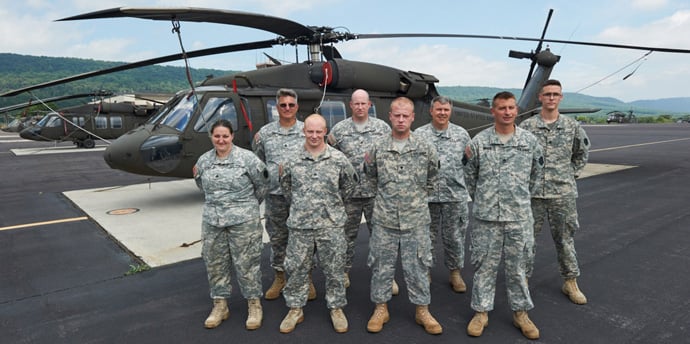FORT INDIANTOWN GAP, PA – It’s a catchphrase for aircraft maintenance crews the world over -- “Keep ‘Em Flying.” The helicopter maintenance crews at the Fort Indiantown Gap base of the Pennsylvania National Guard live it every day.
These technicians care for one of the largest fleets of helicopters in the U.S. Army. They make sure the nearly 50 choppers are in pristine shape when the 28th Combat Aviation Brigade (CAB) trains, deploys overseas or respond to disasters. They also keep the helicopters up and running to serve the Eastern Army Aviation Training School (EAATS) that shares the “ramp,” a term akin to “runway” for fixed winged aircraft.
“It’s mind-blowing how a helicopter works,” said Jay Wilcox, avionics technician. “The engineering and mechanics that go into these machines are amazing.”
The amount of effort that goes into maintaining dual-engine, high tech helicopters is also impressive.
The airfield has an estimated 70,000 takeoffs and landings a year – which equates to a lot of flight time and maintenance. Team members look after UH-60 Black Hawk and CH-47 Chinook helicopters as well as the light utility helicopter the UH-73A Lakota, a military version of the Airbus Eurocopters.
Helicopters are transferred to the base on a rotation – anywhere from a year to three years. When on base, they are the responsibility of the federal technicians to troubleshoot and maintain. Indeed, helicopters from several state National Guard units are sent their way, including West Virginia, Maryland, New Jersey and Connecticut as are helicopters from the United States.
When helicopter units were deployed to Iraq or Afghanistan, technicians are also deployed. In Iraq the maintenance team was publicly recognized by the commanding officer for their work keeping the brigade combat ready.
Overall, the avionic mechanics and electrical team maintain GPS systems, cryptographic devices, multiple radios, batteries checks and tolerances and work on other electronic components. “We must make sure all systems are within certain tolerances,” said Wilcox.
“We deal with all the navigation and communication stuff,” Wilcox said. “We also have electricians who mainly deal with power issues.”
Upon arrival in Indiantown Gap base, a quality assurance section does an initial check of the entire aircraft and combined with written reports from the pilots on any issues, the crews will systematically comb through each system of the aircraft to ensure any problems are fixed.
After that initial check it’s a matter of maintaining the aircraft at intervals.
“We do a lot of preventive maintenance in the Army,” said SFC Nicolas Rarick who supervises the group. “We do phases on multiple aircraft, every 360 hours for Black Hawks and every 200 hours for 47 (Chinook). So every-- and there's ones in-between that that aren't as major.”
The multi-use nature of the base makes for a whir of activity as civilian maintenance crews work inside a massive hangar while in the adjoining the ramp pilots undergo training.
Vibrations are inherent in all helicopters because of the main rotor and thus each helicopter goes through an annual vibration analysis along with thermographic inspections on breaker panels and electrical inspections. Vibration can cause not only mechanical issues but also loosen wires.
Avionics and electrical technicians use Fluke multimeters, including the 27FM and the newer 289, to perform continuity checks on the miles of wiring inside the aircraft, as well as checks on batteries, GPS, radios and other avionics equipment.
The giant Chinook, the CH-47, is one of the workhorses of the military, carrying large vehicles as well as personnel. They’ve looked the same for decades, but depending on the model and era have different sized engines and updated control systems. Some have traditional dials and indicators, whereas the newer aircraft, as you might expect, have computerized displays.
“If you look up underneath these older aircraft, you can see the sheer number of wires that go in and out of everything,” said Wilcox, pointing out large bundle of white wires. “That’s where continuity testing comes in. When we’re testing for breaks in wires and interruptions in signal. That’s where that test really comes in handy because you can see everything is tightly wound and it difficult to see. Without the continuity test something could possibly be broken for a long time.”
Electronic boards are also tested and replaced when needed.
A real asset for the crew is the amount of expertise and capabilities within the base. There is even a machine shop in the event parts need to be crafted from scratch.
“This is a unique program,” said Wilcox. “We’re technically civilians under the Department of the Army but the requirement is to be in the National Guard.”
The federal technician program was started as a readiness program to ensure people with the training, expertise and experience are available to keep the helicopters flying.
“By being federal employees during the day and national guardsmen on the weekend, we capture all that experience and we take it to the weekend or overseas. It’s a unique program. Even though we’re wearing our uniforms, we’re technically not in the Army at the moment,” Wilcox said.
By all indications, it is working as planned.
